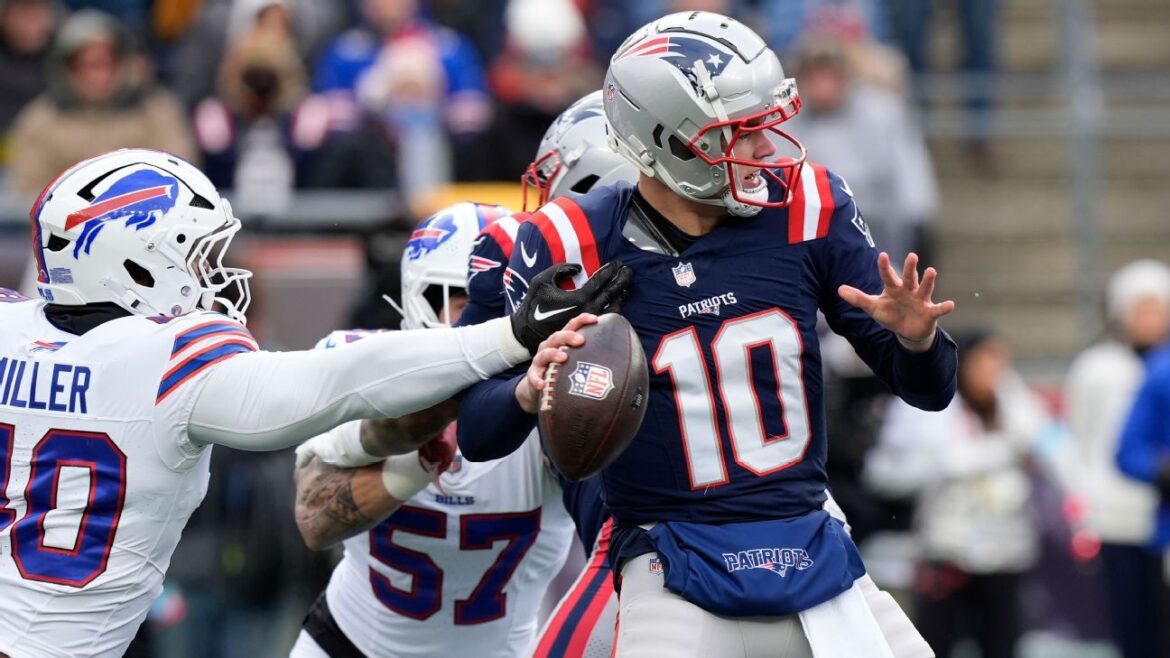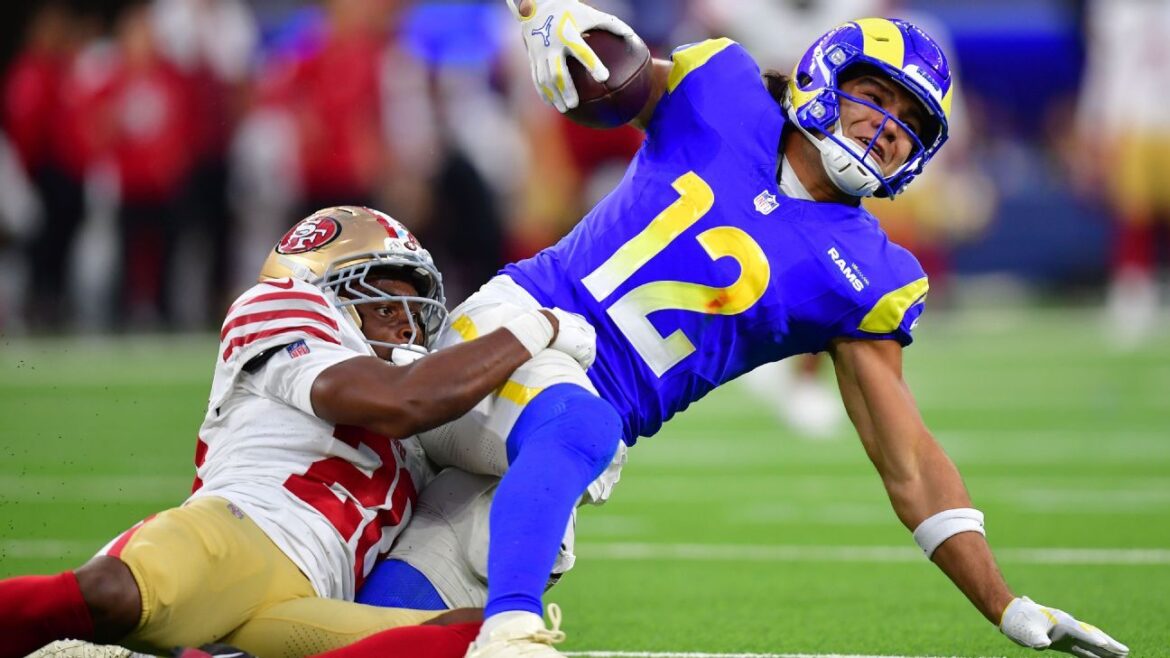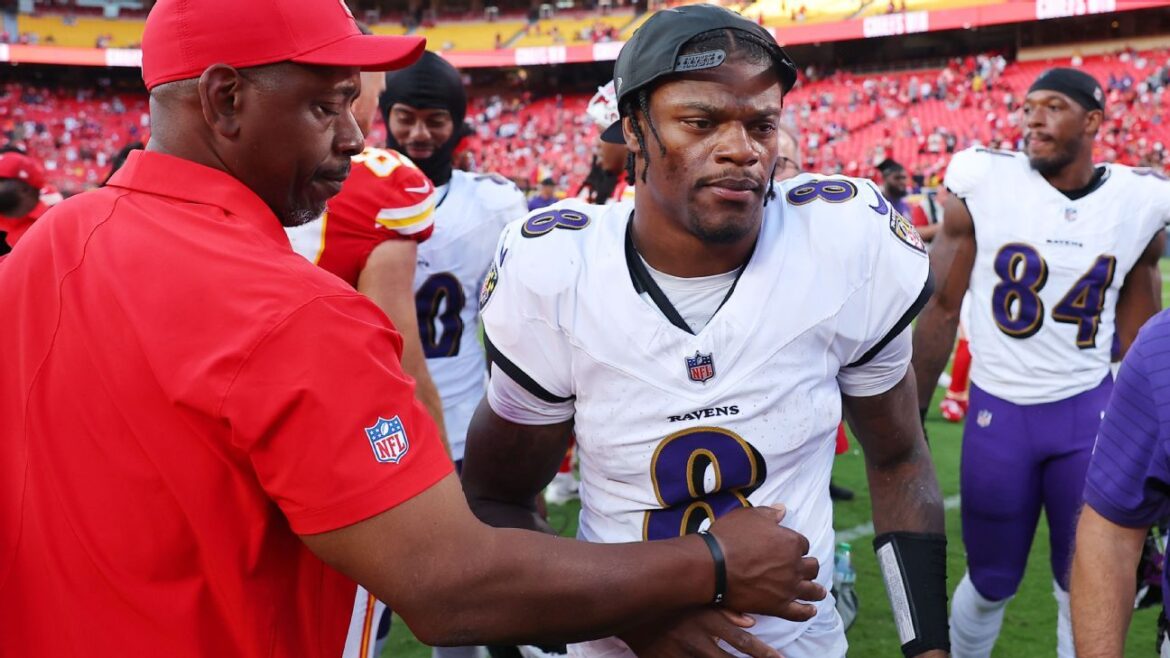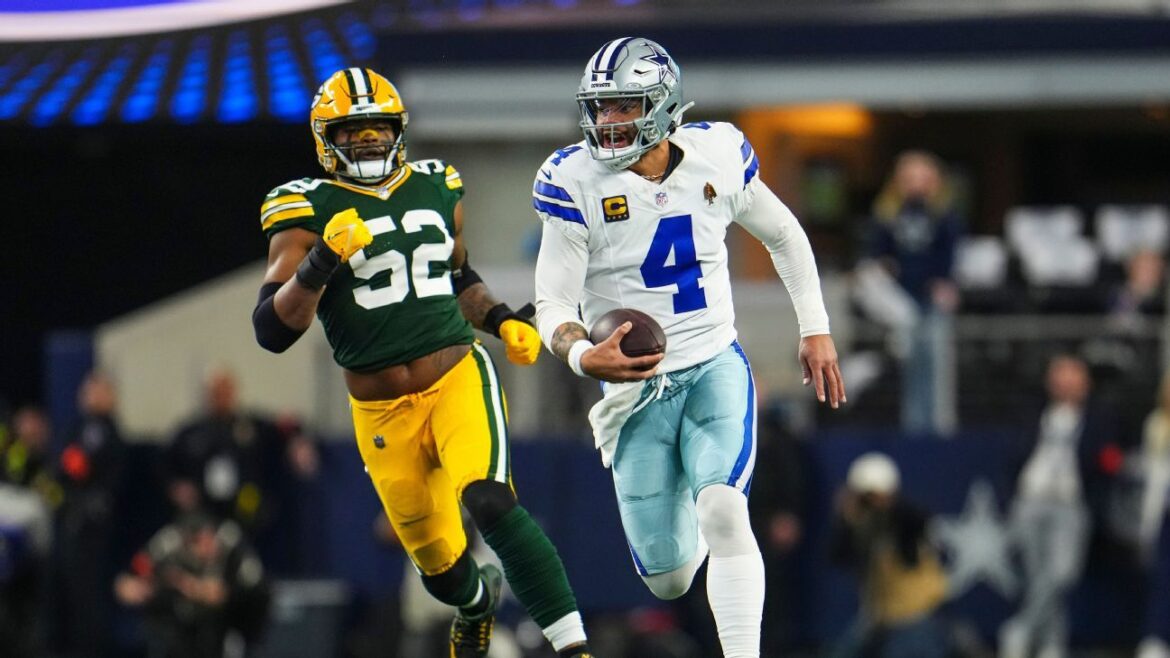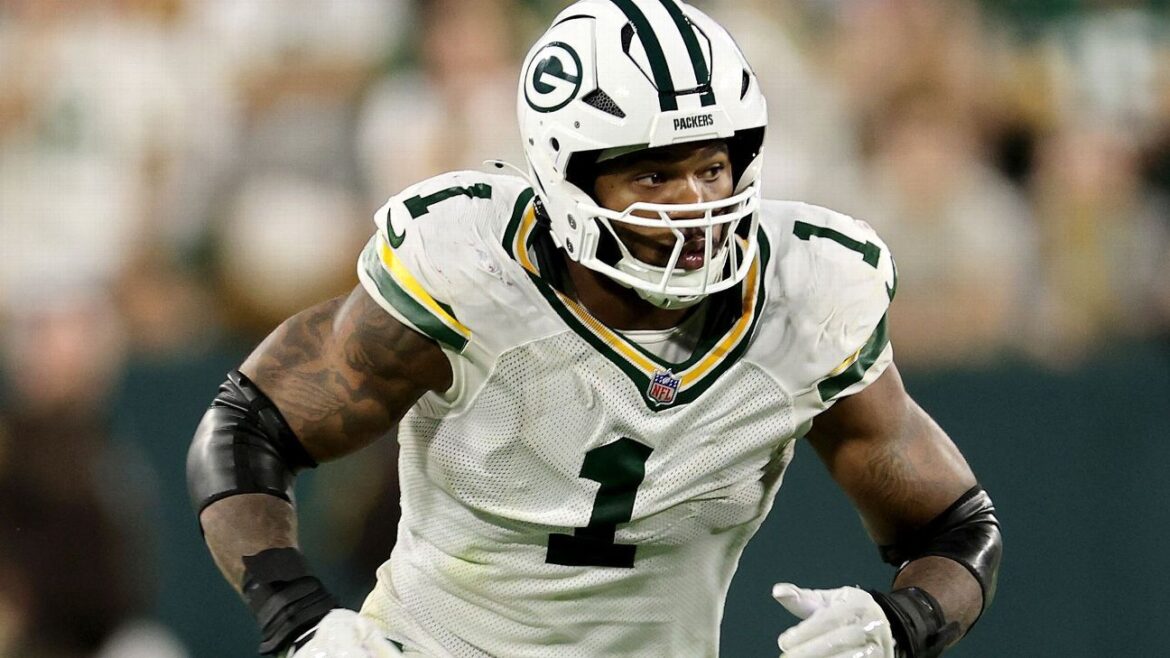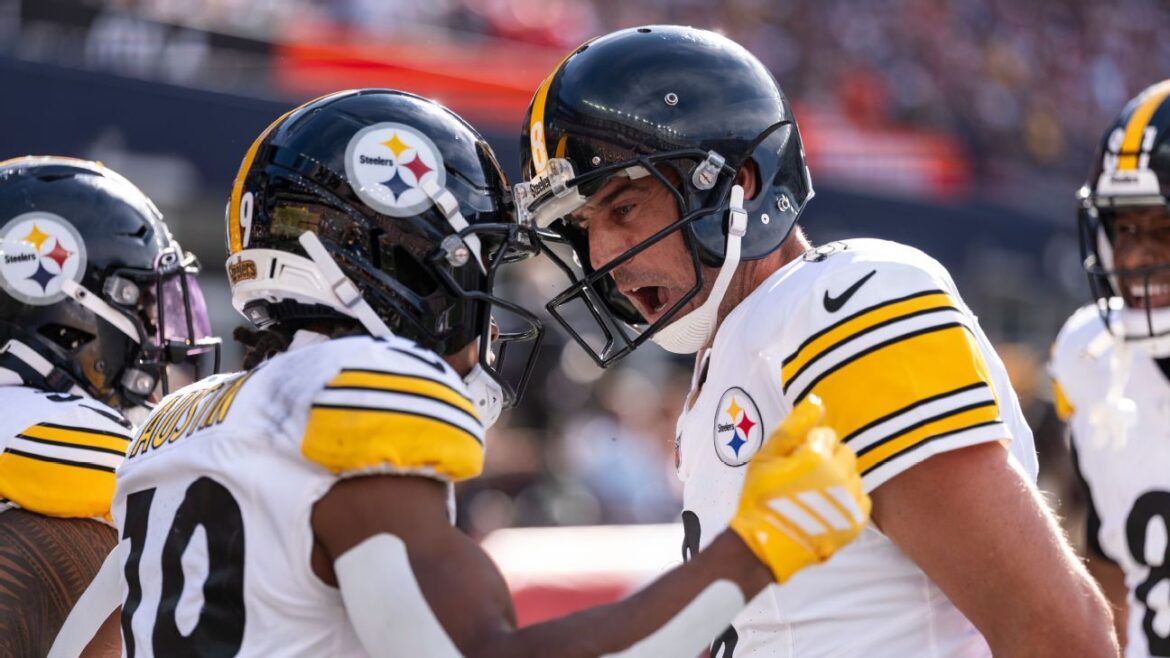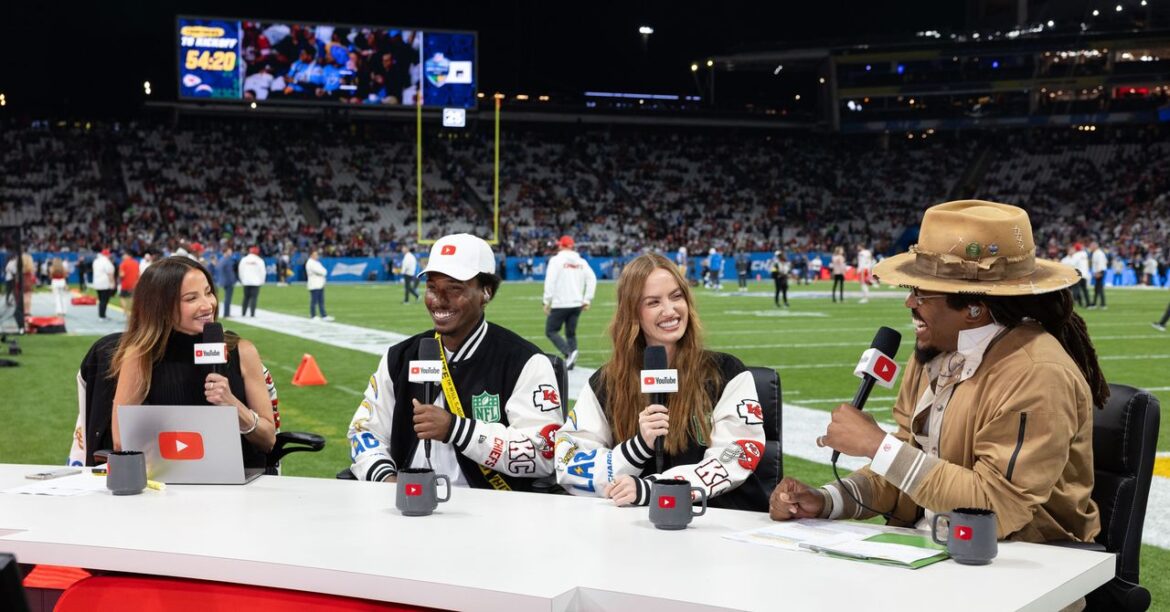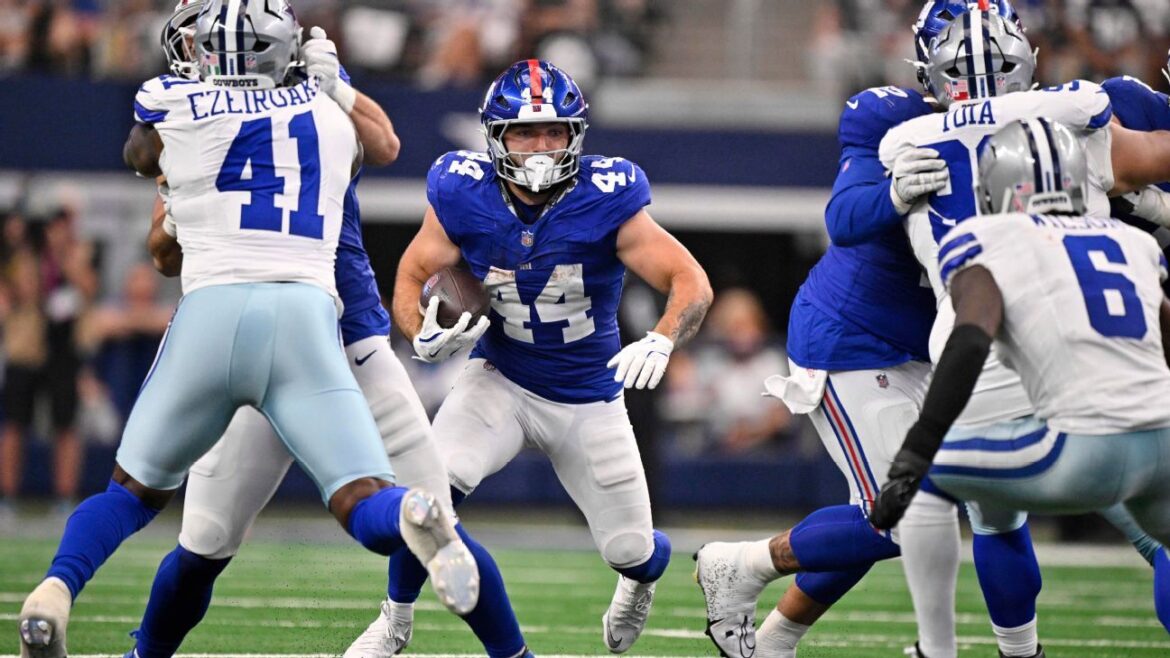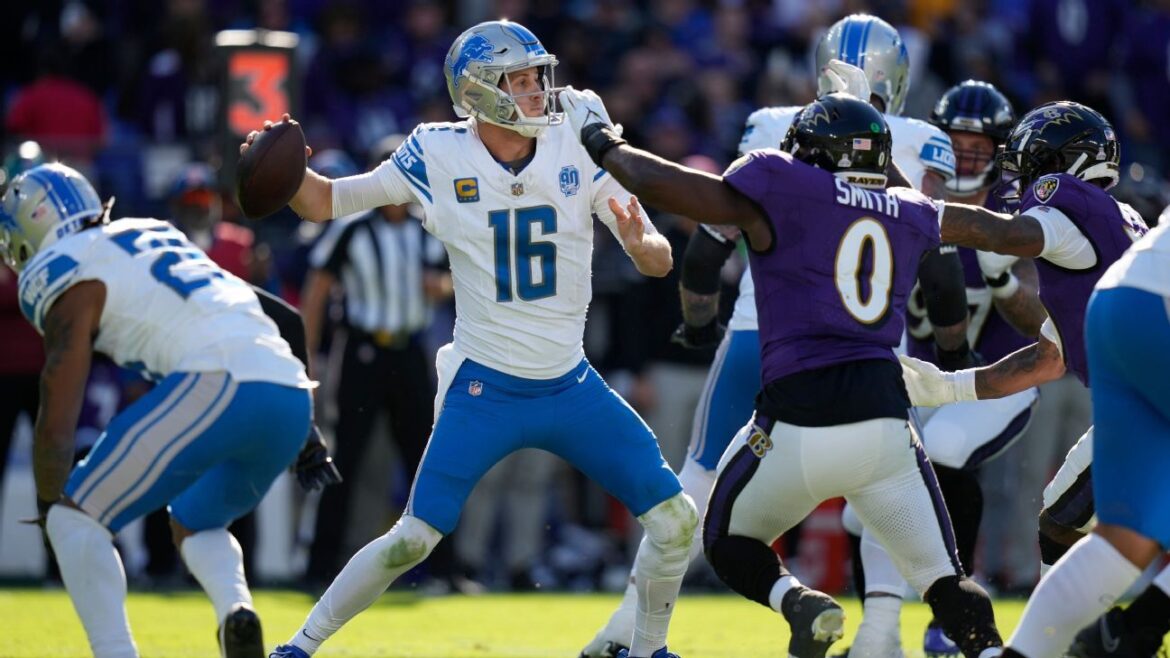The Week 5 NFL schedule for the 2025 season brings some exciting matchups.
Browns rookie QB Dillon Gabriel is making his NFL debut in London against the Vikings. Old teammates in Carolina, QBs Baker Mayfield and Sam Darnold, will face off again in the Bucs-Seahawks matchup. And Commanders QB Jayden Daniels makes his return from injury against the Chargers.
We have you covered with everything you need to know. Our NFL Nation reporters take you inside the locker room with the best thing they heard this week, and ESPN Research provides a key stat to know and a betting nugget for each contest. Plus, analytics writer Seth Walder makes a bold prediction for each matchup, and fantasy analyst Eric Moody shares fantasy football intel. We also have Football Power Index (FPI) matchup quality ratings (out of 100) and game projections, and three analysts — Pamela Maldonado, Moody and Walder — give us final score picks for every game.
Let’s get into the full Week 5 slate, which culminates with a “Monday Night Football” matchup between the Chiefs and Jaguars on ESPN. (Game times are Sunday unless otherwise noted.)
Jump to a matchup:
CLE-MIN | DEN-PHI | HOU-BAL
LV-IND | DAL-NYJ | MIA-CAR
NYG-NO | TB-SEA | TEN-ARI
WSH-LAC | DET-CIN | NE-BUF
KC-JAX
Thursday: SF 26, LAR 23 (OT)
Bye: ATL, CHI, GB, PIT
9:30 a.m. ET | NFL Network | Matchup rating: 35.2/100
ESPN BET: MIN -3.5 (35.5 O/U)
What we’re hearing on the Browns: The Browns are turning to rookie QB Dillon Gabriel in hopes of jump-starting the league’s second-lowest-scoring offense (14 points per game). Gabriel’s first start comes in a bit of an unusual spot — he will become the first quarterback to make his first start in an international game — but Cleveland believes the third-round pick has prepared well for the moment. Expect the Browns to increase their use of rollouts and RPOs to take advantage of Gabriel’s mobility and accuracy. “[Gabriel] knows where to go with the ball. He knows what the coaching staff wants within the offense,” wide receiver Jerry Jeudy said. — Daniel Oyefusi
What we’re hearing on the Vikings: The Vikings spent their week in London sorting through options for an injury-ravaged offensive line, a particularly concerning development given the strength of the Browns’ defensive front. At the very least, the Vikings will be without RT Brian O’Neill (right knee), C Ryan Kelly (concussion) and LG Donovan Jackson (left wrist). Backup C Michael Jurgens (hamstring) sat out practice Wednesday and Thursday, making him very questionable for Sunday’s game. In a worst-case scenario, the Vikings could be left with their No. 3 center, their No. 3 left guard and their No. 2 right tackle against a defense that leads the NFL in pass rush win rate (56%) and run stop win rate (37.7%). — Kevin Seifert
Editor’s Picks
2 Related
Stat to know: The Browns have scored 17 or fewer points in nine straight games dating to last season, which is tied for the longest streak in franchise history. — ESPN Research
Bold prediction: Browns DT Mason Graham will record his first full sack as a pro. It’s hard to get a better opportunity than this, as QB Carson Wentz has taken sacks at a massive 11.5% clip so far this season. — Walder
Injuries: Browns | Vikings
Fantasy nugget: Vikings RB Jordan Mason has had 16 or more touches in consecutive games with Aaron Jones Sr. (hamstring) out. The good news: He’s seeing heavy usage. The bad news: The Vikings’ offensive line has been devastated by injuries and faces a Browns defensive front that previously shut down the Ravens’ Derrick Henry and the Packers’ Josh Jacobs. Cleveland’s defense has allowed just 2.9 yards per carry and the second-fewest rushing yards to backs. See Week 5 rankings. — Moody
Betting nugget: The Vikings are 14-7 ATS (against the spread) in their past 21 road/neutral games. Read more. — ESPN Research
Maldonado’s pick: Browns 24, Vikings 19
Moody’s pick: Vikings 20, Browns 14
Walder’s pick: Browns 18, Vikings 15
FPI prediction: MIN, 62.9% (by an average of 4.8 points)
Matchup must-reads: Browns bench Flacco, turn to Gabriel as starting QB … Vikings’ plan for week between Dublin and London … Vikings’ O’Neill, Kelly injured against Steelers
1 p.m. ET | CBS | Matchup rating: 77.8/100
ESPN BET: PHI -3.5 (43.5 O/U)
What we’re hearing on the Broncos: QB Bo Nix has had many weekly exams in his time as the starter. And this week Nix’s patience will be tested as much as it ever has against an Eagles defense directed by coordinator Vic Fangio. Fangio, who again has two rookie starters on defense (LB Jihaad Campbell and S Andrew Mukuba), will force Nix to live with the underneath throws. Before last week’s win, Nix had not found much success pushing the ball downfield to kick-start the offense. Nix was more settled Monday night, with better footwork and more patience. That will be a necessity in this one as well, given Fangio figures to give Nix a steady diet of simulated pressures and coverage looks that morph after the snap. Fangio has been a particular challenge to quarterbacks in the red zone. — Jeff Legwold
What we’re hearing on the Eagles: The Eagles need to get WR A.J. Brown going. He was held to two catches for 7 yards on nine targets last week and created a stir with a cryptic tweet postgame. Brown has been held to 27 or fewer yards in three of four games. Unsurprisingly, the passing game ranks 31st in the NFL. “I see that we’re struggling and I’m a guy that wants the ball in those times when we can’t find a way. Give it to me,” Brown said Wednesday. — Tim McManus
Stat to know: The Broncos’ defense ranks first in QBR (40.5) and sacks (15), as well as second in pressures (62). — ESPN Research
Bold prediction: Broncos edge Jonathon Cooper will record a sack against Eagles RT Lane Johnson. That’s a tall task considering the opposition, but Cooper has the fastest pass rush get-off in the NFL (among those with at least 50 pass rushes), crossing the line of scrimmage in 0.69 seconds, per NFL Next Gen Stats. — Walder
1:37
Stephen A. isn’t buying A.J. Brown’s claims about his lack of targets
Stephen A. Smith questions whether A.J. Brown’s concerns surrounding his target share are valid.
Injuries: Broncos | Eagles
Fantasy nugget: Eagles TE Dallas Goedert posted a season-high 19.7 fantasy points in Week 4, despite seeing just four targets. He had only two targets in Week 1, missed Week 2 and saw just two in Week 3, yet he has totaled 41.4 fantasy points. Even though the Broncos’ defense is tough, Denver has allowed at least 10 fantasy points to tight ends in two of its past three games. See Week 5 rankings. — Moody
Betting nugget: The Eagles are 9-3 ATS in their past 12 games as favorites. Read more. — ESPN Research
Maldonado’s pick: Eagles 13, Broncos 10
Moody’s pick: Eagles 27, Broncos 23
Walder’s pick: Broncos 23, Eagles 21
FPI prediction: PHI, 61.2% (by an average of 4.2 points)
Matchup must-reads: Jones’ endless energy catalyst for Broncos’ defense … Inside the champagne problems of the Eagles offense
1 p.m. ET | CBS | Matchup rating: 64.9/100
ESPN BET: HOU -2.5 (40.5 O/U)
What we’re hearing on the Texans: The Texans know they’re going against a foe that they’ve struggled with. The Ravens have a 13-2 record against Houston, but coach DeMeco Ryans said, “The past is the past.” Wideout Nico Collins acknowledged the 31-2 blowout loss they suffered on Christmas to Baltimore but said it’s time to “turn the page.” — DJ Bien-Aime
What we’re hearing on the Ravens: The Ravens are 3-0 against Texans QB C.J. Stroud, holding him to an average of seven points per game. But this is expected to be a much different Baltimore defense Sunday. The Ravens have six defensive starters dealing with injuries, including Pro Bowlers in S Kyle Hamilton (groin), MLB Roquan Smith (hamstring) and CB Marlon Humphrey (calf). With all the new players filling in on defense, OLB Tavius Robinson said, “It’s just about doing a little extra in communication.” — Jamison Hensley
Stat to know: The Ravens have allowed 35 points in three of four games this season, tied for the most such games in a season in franchise history (1996 and 2021). — ESPN Research
Bold prediction: Ravens RB Derrick Henry will record a season-high 22-plus rush attempts. The Texans have a ferocious pass rush but struggle to stop the run. QB Lamar Jackson (hamstring) could be out, so the Ravens are going to want to lean on the ground game. — Walder
1:07
Why Dan Orlovsky says Ravens-Texans is a must-win for Baltimore
Dan Orlovsky rips the Ravens and explains why Sunday’s game against the Texans is a must-win, even if Lamar Jackson is sidelined.
Injuries: Texans | Ravens
Fantasy nugget: Texans RB Woody Marks capitalized on a favorable matchup against Tennessee last week, finishing with 21 touches and 27.9 fantasy points. It was the first game in which he out-touched Nick Chubb. He made it count, putting up an outstanding performance despite a Texans offensive line that ranks 24th in run block win rate (68.8%). The good news? Marks has another favorable matchup this week against a Ravens defense that has allowed the sixth-most rushing yards per game to backs (141.3). See Week 5 rankings. — Moody
Betting nugget: The Texans are the only team to go under the total in all four games this season, and the Ravens are the only team to go over the total in every game. Read more. — ESPN Research
Maldonado’s pick: Ravens 23, Texans 14
Moody’s pick: Ravens 23, Texans 20
Walder’s pick: Ravens 20, Texans 17
FPI prediction: BAL, 56.0% (by an average of 2.2 points)
Matchup must-reads: Emergence of rookie RB Marks gives spark to Texans … How the Ravens got to 1-3 and where they go from here … Texans look to beat Ravens for first time since 2014 … What’s wrong with the 1-3 Ravens? Injuries, consistency, more
1 p.m. ET | Fox | Matchup rating: 48.6/100
ESPN BET: IND -6.5 (47.5 O/U)
What we’re hearing on the Raiders: The offensive line is coming off its best performance of the season, but it took a big hit in the process. After the unit allowed just three pressures while paving the way for rookie RB Ashton Jeanty to record 138 yards, it lost starting LT Kolton Miller to a high ankle sprain. Miller’s absence is untimely since the Colts are ranked eight in rushing yards allowed per game (96). Coach Pete Carroll is confident that backup OT Stone Forsythe can step up. “He started 14 games … and started on the left side four or five times. So, we’re confident that he can do the job,” Carroll said. “That’s why we went after him.” — Ryan McFadden
What we’re hearing on the Colts: Indianapolis has had one of the most efficient offenses this season, ranking fourth in scoring at 30.8 points per game. But that comes in spite of its concerning performance in the red zone, where the Colts have managed to score touchdowns only 47.4% of the time (25th in the NFL). They’ve had a rash of ill-timed penalties when in scoring position, and that has led to difficult down-and-distance situations. “We’ve got to get that cleaned up, and it’s just fundamentals and technique,” coach Shane Steichen said. “We’ll address it through practice this week.” — Stephen Holder
Stat to know: Colts rookie Tyler Warren leads all tight ends in receiving yards this season (263), which is the most for the position through four career games in the Super Bowl era. — ESPN Research
Bold prediction: Raiders TE Brock Bowers will record under 30 receiving yards. Bowers hasn’t put up big numbers since injuring his knee in Week 1, and the Colts look like a particularly tough opponent. Only 14% of targets against Indianapolis have gone to tight ends, the fourth-lowest rate in the league. — Walder
All of ESPN. All in one place.
Watch your favorite events in the newly enhanced ESPN App. Learn more about what plan is right for you. Sign Up Now
Injuries: Raiders | Colts
Fantasy nugget: Colts WR Michael Pittman Jr. has scored 15 or more fantasy points in three of four games this season while averaging 7.2 targets. He’s set up for a huge performance against a defense that has allowed the third-most fantasy points per game to wide receivers. See Week 5 rankings. — Moody
Betting nugget: The Raiders are 0-3 ATS in their past three games. Read more. — ESPN Research
Maldonado’s pick: Colts 34, Raiders 28
Moody’s pick: Colts 34, Raiders 24
Walder’s pick: Colts 26, Raiders 21
FPI prediction: IND, 63.9% (by an average of 5.3 points)
Matchup must-reads: Why Booker IV and the Raiders’ D-line will be critical to a win in Indianapolis … Howard abruptly retires, citing ‘family first’
1 p.m. ET | Fox | Matchup rating: 39.7/100
ESPN BET: DAL -2.5 (47.5 O/U)
What we’re hearing on the Cowboys: Didn’t the Cowboys come off a 40-point performance at home, playing at a winless team just two weeks ago? They did. And lost to the Bears in a listless performance. Now coming off a 40-point performance against the Packers, they face the winless Jets. In 2019, the Jets were also 0-4 when facing the Cowboys, and Dallas lost 24-22. The Cowboys can’t repeat what happened to the Bears or what happened in 2019. “We’re judged on wins. I’d say the consistency’s not been there,” coach Brian Schottenheimer said. “The thing we’ve got to do, we’ve got to learn how to finish and how to win.” — Todd Archer
What we’re hearing on the Jets: The gloves are going on — literally. On Thursday, coach Aaron Glenn wore a boxing glove during a ball-security drill, trying to punch out the ball. The Jets have lost a league-high six fumbles, which explains the emphasis in practice. The Jets are a mistake-prone team — minus-seven turnover differential and 40 penalties (tied-seventh most). They’re seeking to avoid their third 0-5 start in the past 30 years. — Rich Cimini
Stat to know: The Jets have allowed 25-plus points in every game this season (the only team in the NFL to do so). Another such game will be tied for the longest streak of allowing 25-plus points in a season in franchise history. — ESPN Research
Bold prediction: Cowboys LB Jack Sanborn will lead the league in tackles this week. The Jets are running at an outrageous clip and are currently sporting a league-low minus-12% pass rate over expectation. As only light underdogs to Dallas, they very well could stick with the ground game for 60 minutes, inducing tons of tackling opportunities for Cowboys linebackers. — Walder
Injuries: Cowboys | Jets
Fantasy nugget: Jets QB Justin Fields finished with 27.1 fantasy points last week and now faces a defense that has allowed the most fantasy points per game to quarterbacks. Dallas has also given up the most rushing attempts and the fifth-highest rushing yards per game to opposing quarterbacks. See Week 5 rankings. — Moody
Betting nugget: Cowboys QB Dak Prescott is 21-14-1 ATS in his career as a road favorite (49-36-2 ATS overall as the favorite). Read more. — ESPN Research
Maldonado’s pick: Jets 24, Cowboys 21
Moody’s pick: Jets 24, Cowboys 23
Walder’s pick: Cowboys 30, Jets 23
FPI prediction: DAL, 63.9% (by an average of 3.5 points)
Matchup must-reads: Pickens keeps impressing Cowboys on, off the field … Jets RB Allen out indefinitely with knee injury … Prescott set Cowboys records but is unsatisfied with tie … Glenn hoping to avoid being first 0-5 Jets coach in Year 1
1 p.m. ET | Fox | Matchup rating: 24.6/100
ESPN BET: MIA -1.5 (44.5 O/U)
What we’re hearing on the Dolphins: Tyreek Hill (knee) will not return this season, but the Dolphins believe they still have a No. 1 receiver in Jaylen Waddle — who returns to that unquestioned role in Hill’s absence. Waddle was Miami’s leading receiver as a rookie in 2021, when he caught 104 passes for 1,015 yards and six touchdowns. Coach Mike McDaniel said the view of Waddle doesn’t change despite Hill’s injury. “I think we’ve looked at him as a wide receiver one,” McDaniel said. “I think that it’s not necessarily a change from the way we approach it the way we see it.” — Marcel Louis-Jacques
What we’re hearing on the Panthers: Coach Dave Canales likes to look at the rash of injuries that have contributed to a 1-3 record as an opportunity for someone else to step up. Unfortunately for him, nobody has. Perhaps it will be rookie WR Jimmy Horn Jr., who will play for the first time after being a healthy scratch the first four games. He brings speed. Or maybe it will be starting WR Xavier Legette, returning after missing two games with a hamstring injury, even though he struggled before the injury. There are plenty of opportunities around. — David Newton
Stat to know: Dolphins QB Tua Tagovailoa has a Total QBR of 19 (33rd) and averages 6.3 yards per attempt (25th) when facing zone coverage this season. The Panthers use zone coverage 68.8% of the time, the seventh-highest rate in the league this season. — ESPN Research
Bold prediction: Panthers WR Tetairoa McMillan will catch multiple passes of 15 air yards or more after having caught exactly one such pass in each of his first four games. The Dolphins’ defense is allowing 9.6 air yards per attempt, second most in the league. — Walder
3:11
Inside the anatomy of Tyreek Hill’s knee injury with Stephania Bell
Using Virtual Medicine, Stephania Bell examines Tyreek Hill’s season-ending knee injury from an anatomical perspective.
Injuries: Dolphins | Panthers
Fantasy nugget: Since the Dolphins acquired Hill in 2022, 76% of QB Tagovailoa’s completions and 82% of his wide receiver yards have gone to Hill or Waddle. In the only game Miami has played without Hill during that span, Waddle caught eight passes for 142 yards and a touchdown. He should once again see plenty of targets against the Panthers. See Week 5 rankings. — Moody
Betting nugget: The Panthers have covered four straight games following a loss (2-0 ATS this season). They are 7-1 ATS in their past eight games following a loss. Read more. — ESPN Research
Maldonado’s pick: Panthers 33, Dolphins 27
Moody’s pick: Panthers 31, Dolphins 28
Walder’s pick: Panthers 23, Dolphins 20
FPI prediction: CAR, 51.3% (by an average of 0.5 points)
Matchup must-reads: WR Hill dislocates knee in win against Jets … Panthers seek answers after embarrassing loss to Patriots … Hill injury FAQ: Recovery timetable, his NFL future, how Miami will adapt
1 p.m. ET | CBS | Matchup rating: 19.6/100
ESPN BET: NO -1.5 (41.5 O/U)
What we’re hearing on the Giants: The Giants are pumping in crowd noise and working on communication at practice throughout the week, especially with this being rookie QB Jaxson Dart’s first career road game. But Dart noted he played in the SEC and has played in a dome before. He’s not looking at the Superdome as any kind of special challenge. He’s more concerned with getting the ball out quicker, getting through his progressions better and avoiding sacks against a Saints defense that has gotten home on a respectable 10% of dropbacks. — Jordan Raanan
What we’re hearing on the Saints: Saints TEs Foster Moreau and Taysom Hill returned to practice this week for the first time since last season, when both sustained serious knee injuries. Though it’s unlikely either will play this weekend, coach Kellen Moore didn’t rule it out completely. Getting both players back will be a big boost to the offense. “With 108 seconds left in the 2024 season, I got a helmet to the outside of the knee on a five-step out route, and my offseason is canceled,” Moreau said. “It’s brutal, and that part of sports is one of the hardest parts. But what doesn’t kill you makes you stronger. And I’ve had a hell of an offseason.” — Katherine Terrell
Stat to know: Giants RB Cam Skattebo has 181 rushing yards and 98 receiving yards through four career games. If he has a productive day Sunday, Skattebo would be the fourth Giants rookie since the 1970 merger with 200 rushing yards and 100 receiving yards through five career games. — ESPN Research
Weekly NFL game expert picks
• Game picks from our NFL experts »
• Betting notes » | More NFL coverage »
Bold prediction: The Giants will deliver double-digit quarterback hits in a win Sunday. After a bit of a slow start, edge rusher Abdul Carter looked dominant last week, and now the Giants face a Saints team that ranks 29th in pass block win rate (51.9%). — Walder
Injuries: Giants | Saints
Fantasy nugget: Dart finished with 19.8 fantasy points last week, with 11.4 of those points coming from rushing. This is a great matchup for Dart, Wan’Dale Robinson and Darius Slayton against a defense that has allowed the fifth-most fantasy points per game to quarterbacks. See Week 5 rankings. — Moody
Betting nugget: Saints QB Spencer Rattler is 0-10 outright and 2-8 ATS in his career as a starter. Read more. — ESPN Research
Maldonado’s pick: Saints 23, Giants 20
Moody’s pick: Saints 20, Giants 18
Walder’s pick: Giants 23, Saints 16
FPI prediction: NO, 53.5% (by an average of 1.4 points)
Matchup must-reads: Dart on Saints draft snub: ‘Always a chip on your shoulder’ … Saints ‘got to find a way to get a win’ with Giants looming
4:05 p.m. ET | CBS | Matchup rating: 57.7/100
ESPN BET: SEA -3.5 (45.5 O/U)
What we’re hearing on the Buccaneers: The Bucs have surrendered touchdowns on the first defensive possession in three of their four games, but have only scored on the first offensive possession once. That is a big reason why they’ve had to come from behind in the final two minutes of their games, which have all been decided by one score or less. QB Baker Mayfield said of this week’s game: “[We’ve] got to start faster, [we’ve] got to be the aggressor, not wait [for] whether it’s chippy or we get hit in the mouth once. We’ve got to come out swinging.” — Jenna Laine
What we’re hearing on the Seahawks: Coach Mike Macdonald said that by the Seahawks’ in-house metrics, Mayfield is probably the best quarterback in the NFL right now in terms of extended-play situations. “That’s something you have to deal with, but he also plays on time,” Macdonald said. “He’s extremely accurate, he’s got a great arm, and then when he extends plays, obviously he’s a great competitor.” Mayfield has the eighth-fastest average time before throw at 2.68 seconds. — Brady Henderson
Stat to know: The Bucs have scored and allowed an identical 97 points so far this season. — ESPN Research
Bold prediction: Seahawks edge Boye Mafe will record a 25% pass rush win rate — or better. When DeMarcus Lawrence (quadriceps) got hurt in last week’s game, Mafe moved to play more opposite the right tackle. That’s where you want to be against the Bucs right now, with Charlie Heck (80% pass block win rate) currently stationed there. Assuming Lawrence either misses the game or plays less, that should set up Mafe to make a pass-rushing impact. — Walder
1:20
Smith-Njigba on Seattle’s offense: Darnold has been next level
Seahawks WR Jaxon Smith-Njigba joins “The Rich Eisen Show” to explain why Seattle’s offense has started to click this season.
Injuries: Buccaneers | Seahawks
Fantasy nugget: Seahawks QB Sam Darnold has averaged 16.2 fantasy points over his past three games in an offense that ranks fourth in rushing attempts per game. Seattle may need to lean on the passing game against a defensive front that allows the fewest rushing yards to running backs, but Tampa Bay also gives up the eighth-most fantasy points to quarterbacks. See Week 5 rankings. — Moody
Betting nugget: The Bucs are 6-1 ATS after a loss since the start of last season, and 11-4 ATS after a loss with Mayfield (since 2023). Read more. — ESPN Research
Maldonado’s pick: Seahawks 35, Buccaneers 25
Moody’s pick: Seahawks 26, Buccaneers 24
Walder’s pick: Seahawks 27, Buccaneers 17
FPI prediction: SEA, 53.9% (by an average of 1.5 points)
Matchup must-read: Seahawks sign Darnold’s praises after game-winning drive
4:05 p.m. ET | CBS | Matchup rating: 25.2/100
ESPN BET: ARI -7.5 (42.5 O/U)
What we’re hearing on the Titans: The Titans’ defense will do its best to keep Cardinals QB Kyler Murray from breaking off long runs by design or circumstance. Defensive coordinator Dennard Wilson said the pass rush has to be coordinated and disciplined to make sure the defense doesn’t leave an escape lane for Murray to leak through. “He tries to get outside the pocket, they have some options with him,” Wilson said. “Things like that with the run pass option and all those things, so we got to keep ’em in a well, we got to contain ’em.” — Turron Davenport
What we’re hearing on the Cardinals: Murray is trying to keep his head down and focus on the present with the state of the Cardinals’ offense, which struggled mightily in seven of its past eight quarters. Aside from the fourth quarter in a loss to the Seahawks last Thursday night, Arizona’s offense struggled to move the ball and score in Weeks 3 and 4. But Murray said it’s hard and the “human in me” wants to look at the totality of Arizona’s issues, but focusing on today takes discipline, he said. “I try not to look at the big picture, because s— gets you get frustrated looking at the big picture,” Murray said. — Josh Weinfuss
Stat to know: Titans QB Cam Ward has been sacked an NFL-high 17 times this season, while the Cardinals rank fifth in pass rush win rate this season (47%). — ESPN Research
Bold prediction: Cardinals RB Michael Carter will record 80 or more rushing yards. It’s hard to know exactly how the Cardinals’ backfield work will shake out in light of Trey Benson’s move to IR, but whoever gets the rush attempts should be put in a great position for success: The Titans rank fourth worst in terms of EPA allowed per opponent rush (.09). — Walder
Injuries: Titans | Cardinals
Fantasy nugget: The Cardinals’ backfield is thin with Benson (knee) and James Conner out. Emari Demercado is now positioned to lead the Cardinals’ running back committee. He’s firmly on the flex radar in Week 5 against a Titans defense that allows the fourth-most fantasy points to backs. See Week 5 rankings. — Moody
Betting nugget: The Titans are 3-18 ATS under Brian Callahan, the worst record for any coach in the Super Bowl era (min. five games). Read more. — ESPN Research
Maldonado’s pick: Cardinals 28, Titans 23
Moody’s pick: Cardinals 27, Titans 16
Walder’s pick: Cardinals 28, Titans 14
FPI prediction: ARI, 73.4% (by an average of 9.7 points)
Matchup must-reads: Despite 0-4 start, Titans still believe they can right ship … Cardinals need to fill void in injury-depleted running back room … Ward vents frustration after Titans blanked, fall to 0-4 … Harrison keeping trust in self amid inconsistencies
4:25 p.m. ET | Fox | Matchup rating: 71.3/100
ESPN BET: LAC -2.5 (48.5 O/U)
What we’re hearing on the Commanders: Washington’s defense continues to be plagued by explosive plays, having allowed an NFL-worst 28 pass plays of 15 yards or more. It has been a combination of mistakes: communication and players abandoning assignments trying to make a big play. They’ll have to guard Chargers QB Justin Herbert, who ranks 11th with 20 pass plays of at least 15 yards. Of those plays, he has completed seven with three touchdowns to WR Quentin Johnston. “If we clean up the explosive passes, we’re playing solid,” said defensive coordinator Joe Whitt Jr. “Right now we’re playing sloppy. We will clean it up.” — John Keim
What we’re hearing on the Chargers: After a game where Herbert was hit 13 times and sacked twice, the Chargers could be without two starting offensive linemen again Sunday. LT Joe Alt (ankle) is doubtful for Sunday, and RG Mekhi Becton (concussion) didn’t play last week. “Just go out there and execute and do what you’ve been trained to do,” Herbert said of his message to backups. “They’re playmakers, too.” — Kris Rhim
Stat to know: This will be a staunch matchup in the red zone. The Commanders have scored touchdowns on seven of nine such drives (78%). The Chargers have allowed touchdowns on four of 13 such drives (31%). — ESPN Research
Bold prediction: Commanders QB Jayden Daniels will complete fewer than 10 passes to wide receivers. Chargers CBs Donte Jackson and Tarheeb Still both rank in the top five in lowest yards per coverage snap allowed among outside corners with at least 100 coverage snaps, per NFL Next Gen Stats. That will make throwing outside difficult in any circumstance, and even more with Washington missing WR Terry McLaurin (quadriceps) because of injury. — Walder
Best of NFL Nation
• How the 49ers rebuilt roster around Purdy
• Rams WR Puka Nacua is hammer, not nail
• Aaron Glenn, Jets hoping to avoid being 0-5
• Saints trying to find a way to get a win
• Rules change leads to most returns in history
Injuries: Commanders | Chargers
Fantasy nugget: Herbert struggled to capitalize in a favorable matchup against the Giants, finishing with a season-low 12.5 fantasy points. However, his fortunes (and those of fantasy managers) could change against the Commanders, who have allowed the seventh-most fantasy points per game to quarterbacks. Herbert also has an elite trio of receivers in Johnston, Ladd McConkey and Keenan Allen, who should help him bounce back. See Week 5 rankings. — Moody
Betting nugget: Three straight Chargers games have gone under the total. Read more. — ESPN Research
Maldonado’s pick: Chargers 20, Commanders 10
Moody’s pick: Chargers 27, Commanders 21
Walder’s pick: Chargers 30, Commanders 17
FPI prediction: LAC, 58.2% (by an average of 3.1 points)
Matchup must-reads: QB Daniels (knee) plans to play vs. Chargers … Alt doubtful to play Sunday, Harbaugh says … Commanders’ D focused on execution after flop vs. Falcons … Chargers’ Harbaugh: Hits Herbert taking ‘very concerning’
4:25 p.m. ET | Fox | Matchup rating: 66.0/100
ESPN BET: DET -10.5 (49.5 O/U)
What we’re hearing on the Lions: It’ll be an emotional homecoming for Lions RB David Montgomery as he plays in his hometown for the first time in his NFL career. He played the Bengals once in 2021 with the Bears in Chicago (20 rushes, 61 yards), but he has never had a road game against the Bengals. Montgomery attended Mount Healthy (Ohio) High School, where he earned All-State honors as a dual-threat QB. He is coming off a season-low 12 rushing yards with nine carries against Cleveland, but is looking to get back on track in a familiar setting in front of family and friends. “He’s going to kill it,” Arvie Crouch, Montgomery’s high school coach, told ESPN. — Eric Woodyard
What we’re hearing on the Bengals: This game will be a gut check for the Bengals in every way possible. The Lions are expected to steamroller Cincinnati, which is in some of the worst form in franchise history. Detroit is second in the NFL in rate of designed rush plays, per ESPN Research. The Bengals’ rush defense will have to limit big plays, and stopping those will come down to deploying basic techniques. Said defensive coordinator Al Golden: “Just defend your gap, keep the ball on your inside pad. Play with leverage.” — Ben Baby
Stat to know: Bengals WR Ja’Marr Chase is seeking to avoid going three straight games with 50 or fewer receiving yards for the second time in his career. — ESPN Research
Bold prediction: Bengals QB Jake Browning will record a 60-plus QBR. Don’t get me wrong: Confidence in Browning has dropped off dramatically from where it was a few weeks ago. But then again, the two defenses he has played have been the Vikings and Broncos, and it doesn’t get much tougher than that. Considering his past success, I think there’s still hope for him and the Bengals. — Walder
1:49
Stephen A.: Bengals’ season is a ‘wash’ without Burrow
Stephen A. Smith breaks down the struggles facing the Bengals with star quarterback Joe Burrow injured.
Injuries: Lions | Bengals
Fantasy nugget: Lions QB Jared Goff has averaged just 14.1 fantasy points per game on the road since 2021. Detroit would be wise to lean heavily on Jahmyr Gibbs, Montgomery and the running game. This matchup also has one of the higher totals on the slate, and the Bengals’ defense has given up the second-most fantasy points per game to running backs. See Week 5 rankings. — Moody
Betting nugget: The Lions are 11-2 ATS as road favorites since 2023. Read more. — ESPN Research
Maldonado’s pick: Lions 37, Bengals 34
Moody’s pick: Lions 33 Bengals 17
Walder’s pick: Lions 31, Bengals 26
FPI prediction: DET, 76.9% (by an average of 11.0 points)
Matchup must-reads: Lions put CB Reed on IR due to hamstring … QB Browning has Taylor’s ‘unwavering’ confidence … St. Brown-Goff connection shines again in 2 TD day vs. Browns
8:20 p.m. ET | NBC | Matchup rating: 64.4/100
ESPN BET: BUF -7.5 (49.5 O/U)
What we’re hearing on the Patriots: An unexpected injury issue popped up with one of the Patriots’ best players, as starting DT Milton Williams was added to the injury report Wednesday as a limited participant because of his ankle. Then Williams didn’t practice Thursday. He has played 72% of the defensive snaps through four games, has two sacks and has consistently created interior pressure. If he doesn’t play, that could thrust Khyiris Tonga into a starting role next to Christian Barmore. — Mike Reiss
What we’re hearing on the Bills: How will the rushing offense, which has been key to start the season, respond to the challenge the Patriots’ defense presents? RB James Cook has led Buffalo on the ground and has 100-plus yards in three straight games. New England, however, is tied for second in opponent rushing yards per game (77.5) and yards per rush (3.3). “[Cook] has such a really good understanding of what we’re trying to do, and how the guys are blocking and reading it. And he’s really special right now,” offensive coordinator Joe Brady said. — Alaina Getzenberg
Stat to know: Bills QB Josh Allen has 45 career games with both a passing touchdown and a rushing touchdown, tied with Cam Newton for the most by any player in NFL history. — ESPN Research
Bold prediction: Patriots rookie RB TreVeyon Henderson will record 64 or more rushing yards, doubling his current career high. Bills opponents have recorded a minus-14% pass rate over expectation this season, by far the lowest in the league. The Bills’ defense induces opponents’ runs. — Walder
Injuries: Patriots | Bills
Fantasy nugget: Bills TE Dalton Kincaid continues to split snaps and routes with others in the position group. You want to prioritize him in favorable matchups, like this week’s, which features one of the highest point totals on the slate. Kincaid catches passes from Allen in a Bills offense that ranks second in total yards per game. He faces a defense that gives up the ninth-most fantasy points per game to tight ends. See Week 5 rankings. — Moody
Betting nugget: The Patriots have covered four straight meetings with two outright wins as underdogs. Read more. — ESPN Research
Maldonado’s pick: Bills 38, Patriots 24
Moody’s pick: Bills 34, Patriots 24
Walder’s pick: Bills 31, Patriots 27
FPI prediction: BUF, 67.5% (by an average of 7.2 points)
Matchup must-reads: Diggs’ comeback is underway with the Patriots … Will Bosa’s final(?) chapter end with a happy ending in Buffalo?
Monday, 8:15 p.m. ET | ESPN | Matchup rating: 68.5/100
ESPN BET: KC -3.5 (46.5 O/U)
What we’re hearing on the Chiefs: The Chiefs know that Jaguars star Travis Etienne Jr. will be the best RB they’ve faced so far this season — and that list already includes Baltimore’s Derrick Henry and Philadelphia’s Saquon Barkley. Etienne has powered the Jaguars’ offense with 394 rushing yards, the third most in the league. “What’s stuck out to me watching film the past few days is how well he is on the edge,” LB Leo Chenal said of Etienne. “His stiff-arm is good, but it’s not just setting an edge. You have to have great eyes and continue to press the edge because he’ll bounce it out even if you’ve got a [defensive end] setting the edge two yards up the field. You better be ready to knock down a stiff-arm.” — Nate Taylor
What we’re hearing on the Jaguars: One of the things being stressed to the defensive players this week: Don’t get discouraged. QB Patrick Mahomes is an escape artist who can turn a bad play into a huge gain with an off-schedule throw from a weird arm angle. It’s going to happen at least once, but the key is to forget about it immediately when it does. “We’ve just got to go and huddle up, call the next play, refocus and understand that they’ve got good players, too, and they’re going to make some [big plays],” coach Liam Coen said. — Michael DiRocco
Stat to know: The Jaguars enter Week 5 leading the NFL in drops this season (10) and are the only team with a double-digit drop total. — ESPN Research
Bold prediction: Jaguars slot CB Jourdan Lewis will not allow a single reception to Chiefs WRs Hollywood Brown or JuJu Smith-Schuster while covering them. Lewis has allowed 0.7 yards per coverage snap this season (fifth best among slot corners with at least 80 coverage snaps) along with a minus-17% completion percentage over expectation, per NFL Next Gen Stats. — Walder
1:35
Why Worthy wants same chemistry with Mahomes as Kelce
Xavier Worthy joins “The Rich Eisen Show” to share his favorite Patrick Mahomes moment and reflects on why playing with him is a blessing.
Injuries: Chiefs | Jaguars
Fantasy nugget: The Chiefs’ defensive front ranks 31st in run stop win rate (25.5%), while the Jaguars’ offensive line ranks second in run block win rate (76.5%). This is an advantage Jacksonville must exploit, and with Etienne, it should be able to do so. He has had 16-plus touches in every game this season, and 17-plus fantasy points in three of them. See Week 5 rankings. — Moody
Betting nugget: The Chiefs are 4-1 ATS in their past five games as favorites. Read more. — ESPN Research
Maldonado’s pick: Chiefs 24, Jaguars 21
Moody’s pick: Chiefs 23, Jaguars 22
Walder’s pick: Chiefs 24, Jaguars 21
FPI prediction: KC, 62.8% (by an average of 5.1 points)
Matchup must-reads: WR Worthy unlocks Chiefs’ offense in return from shoulder injury … Coen has revived the Jaguars’ run game … Jaguars’ Walker has wrist surgery, could play vs. Chiefs

